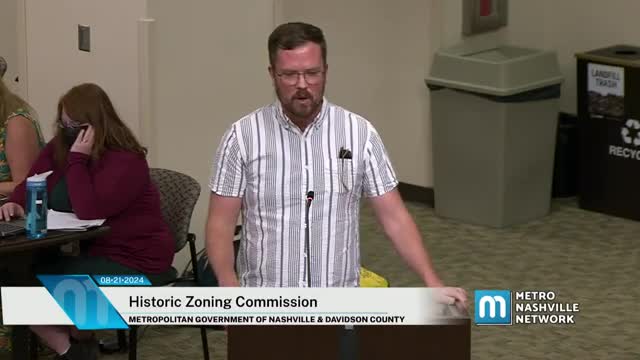Homeowner Faces Tough Decision Over Historic Property Violation
August 21, 2024 | Historic Zoning Commission Meetings, Nashville, Davidson County, Tennessee
This article was created by AI summarizing key points discussed. AI makes mistakes, so for full details and context, please refer to the video of the full meeting. Please report any errors so we can fix them. Report an error »

In a recent government meeting, officials grappled with a complex case involving a property violation that has left a new homeowner in a challenging position. The discussion centered around a violation related to unpermitted exterior work on a house, which was discovered only after the new owner applied for a separate project.
Commission members expressed empathy for the homeowner, noting that the violation stemmed from actions taken by the previous owner, who had benefited from the unauthorized modifications. The current owner, who had no knowledge of the violation at the time of purchase, now faces the possibility of being held accountable for rectifying the situation.
Concerns were raised about the fairness of penalizing the new owner for a violation they did not commit, with some members suggesting that the violation should follow the property rather than the individual. This would mean that any future work on the property would require addressing the violation, without imposing an immediate burden on the current owner.
Legal implications were also discussed, with recommendations for the homeowner to seek restitution from the previous owner. However, the commission acknowledged that the situation is complicated, as the violation raises safety concerns and must be addressed to comply with local codes and historic preservation guidelines.
The meeting concluded with a consensus that while the commission sympathizes with the homeowner's plight, they must also uphold regulations to ensure safety and compliance. A motion was proposed to allow the homeowner additional time to address the violation, with suggestions to extend the deadline significantly beyond the initial 90 days, reflecting the complexities involved in resolving the matter.
Overall, the case highlights the challenges faced by homeowners when previous owners fail to adhere to permitting processes, raising questions about accountability and the enforcement of building regulations.
Commission members expressed empathy for the homeowner, noting that the violation stemmed from actions taken by the previous owner, who had benefited from the unauthorized modifications. The current owner, who had no knowledge of the violation at the time of purchase, now faces the possibility of being held accountable for rectifying the situation.
Concerns were raised about the fairness of penalizing the new owner for a violation they did not commit, with some members suggesting that the violation should follow the property rather than the individual. This would mean that any future work on the property would require addressing the violation, without imposing an immediate burden on the current owner.
Legal implications were also discussed, with recommendations for the homeowner to seek restitution from the previous owner. However, the commission acknowledged that the situation is complicated, as the violation raises safety concerns and must be addressed to comply with local codes and historic preservation guidelines.
The meeting concluded with a consensus that while the commission sympathizes with the homeowner's plight, they must also uphold regulations to ensure safety and compliance. A motion was proposed to allow the homeowner additional time to address the violation, with suggestions to extend the deadline significantly beyond the initial 90 days, reflecting the complexities involved in resolving the matter.
Overall, the case highlights the challenges faced by homeowners when previous owners fail to adhere to permitting processes, raising questions about accountability and the enforcement of building regulations.
View full meeting
This article is based on a recent meeting—watch the full video and explore the complete transcript for deeper insights into the discussion.
View full meeting
